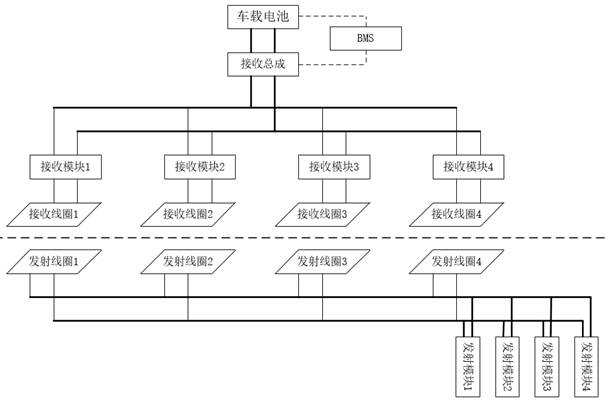Control method, device, system and electric vehicle of wireless charging system
A technology of wireless charging and control methods, applied in electric vehicles, circuit devices, battery circuit devices, etc., can solve the problems of high integration and unfavorable modular design of wireless charging systems, and achieve the effect of reducing design difficulty and increasing safety.
- Summary
- Abstract
- Description
- Claims
- Application Information
AI Technical Summary
Problems solved by technology
Method used
Image
Examples
Embodiment 1
[0077] In some alternative examples, please refer to image 3 , image 3 It is a schematic flowchart of an embodiment of a control method of a wireless charging system in the present application.
[0078] Such as image 3 As shown, the first aspect of the present application provides a control method for a wireless charging system, including:
[0079] S1100. Obtain the total output power required by the wireless charging system, wherein the wireless charging system includes N wireless transmission modules, the wireless transmission module includes a transmitting module and a corresponding receiving module, and N≥1;
[0080] During implementation, the wireless charging system includes a receiving end and a transmitting end, wherein the receiving end includes N receiving modules, and the transmitting end includes N transmitting modules. A transmitting module and a receiving module are set in pairs to form a wireless transmission module. The receiving module The output power i...
Embodiment 2
[0100] In some alternative embodiments, see Figure 5 , Figure 5 It is a schematic flow chart of calculating the output power of the receiving module in an embodiment of the present application.
[0101] Such as Figure 5 As shown, the steps of calculating the output power of the receiving module according to the total output power include:
[0102] S1210. Obtain the rated output power of the receiving module;
[0103] S1220. According to the total output power and the rated output power, calculate and confirm the quantity information of the receiving modules participating in the wireless power transmission and the output power of each receiving module.
[0104] During implementation, the rated output power is the maximum output power of the receiving module under normal working conditions. The system calculates the number of receiving modules participating in wireless power transmission according to the total output power and the rated output power, as well as the output ...
Embodiment 3
[0106] In some alternative embodiments, see Image 6 , Image 6 It is a basic flow chart of an embodiment of the present application to control part of the transmission module to stop working.
[0107] Such as Image 6 As shown, after the step of controlling the output transmission power of the corresponding transmitting modules so that the sum of the output powers of the N receiving modules meets the total output power, the control method of the wireless charging system provided by the present application further includes the following steps:
[0108] S1510. Obtain a charging current signal required by the target battery, wherein the charging power of the target battery is the total output power;
[0109] During the implementation, during the charging process of the target battery, as the power is gradually full, the charging power will decrease, that is, the charging current required by the target battery will also decrease. The system monitors the charging current signal ...
PUM
 Login to View More
Login to View More Abstract
Description
Claims
Application Information
 Login to View More
Login to View More - R&D
- Intellectual Property
- Life Sciences
- Materials
- Tech Scout
- Unparalleled Data Quality
- Higher Quality Content
- 60% Fewer Hallucinations
Browse by: Latest US Patents, China's latest patents, Technical Efficacy Thesaurus, Application Domain, Technology Topic, Popular Technical Reports.
© 2025 PatSnap. All rights reserved.Legal|Privacy policy|Modern Slavery Act Transparency Statement|Sitemap|About US| Contact US: help@patsnap.com



